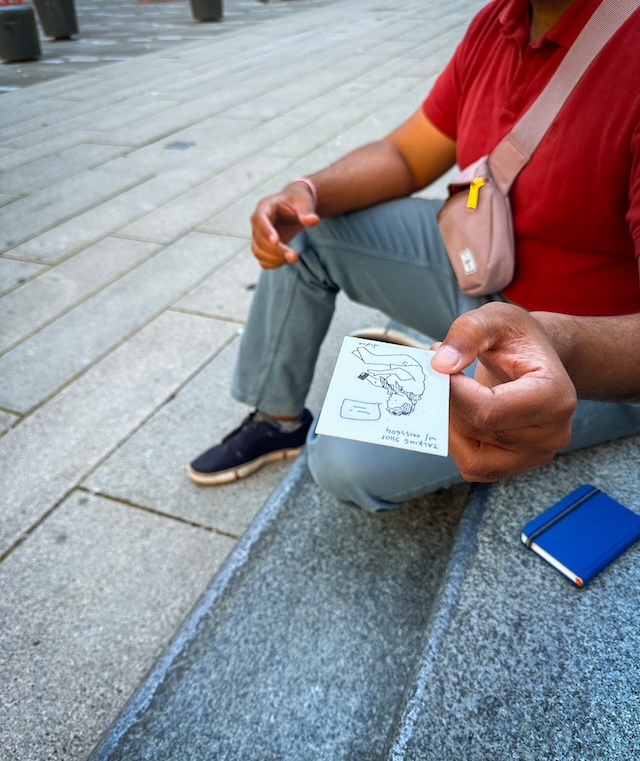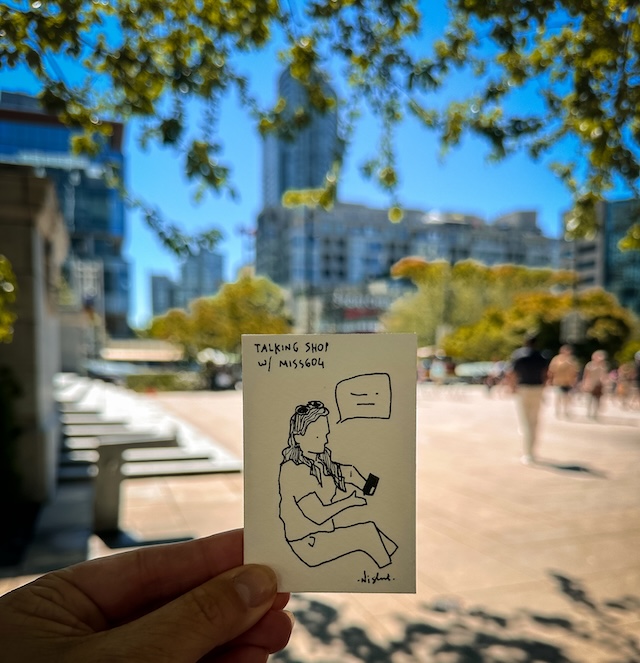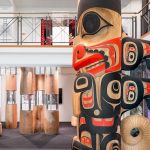Meeting The Sneaky Artist
Artist, writer, and podcaster Nishant Jain, known as The Sneaky Artist, ‘sits in public spaces with a sketchbook and fountain pen, making secret drawings of city life.’ It was fitting that my first encounter with him took place at Robson Square.
This vibrant public space, often a bustling thoroughfare for me as I beeline through on my way home from Whitecaps matches at BC Place, set the stage for our morning meeting.
- A Conversation with The Sneaky Artist
- Finding Home in Vancouver
- The Value of art, With a Small a
- Dear Stranger, This is For You
- Upcoming Events

I found a seat at the lone shaded table, recently vacated by city workers on a coffee break. Settling in, I scanned the square slowly, panning like a surveillance camera, trying to spot The Sneaky Artist before he found me. It was one of those seasonably warm summer mornings in the city, where the lack of rain has created sticky film on the sidewalks and surfaces, and the pavement radiates heat by 10am.
A familiar downtown scene unfolded: the Law Courts on one side, Robson Square rink and UBC campus below, and the Vancouver Art Gallery behind me.
There was a bicycle courier on the steps thumbing through his phone, while two friends in flowy skirts sitting in direct sunlight having a lively conversation over iced coffees. On the shrub-covered hill – an island in the middle of all the concrete – sat a figure with a large sketch-pad and pencils. Everytime they looked up I thought about the words “Placed Upon the Horizon (Casting Shadows)” which is on the south facade of the gallery in front of them, and behind me.
“Rebecca?” Nishant found me and greeted me with a hug. It’s been a very long time since I met someone I had only previously chatted with on social media. He and I have been avid users of Threads, Instagram’s X alternative that launched in the summer of 2023, and connected there through Likes and Comments. The Sneaky Artist has over 333,000 followers on Instagram (and nearly 68,000 on Threads) both with the tagline “secretly drawn art of the world.”
Nishant made waves a few years ago, when he first moved to Vancouver from the Midwest, bringing his popular street art with him. The CBC featured him when he was an Artist in Residence with TransLink in 2022, and he recently launched a merchandise line with 49th Parallel Coffee. He has a series of events this month, including one with the Indian Summer Festival and another with Downtown Van, and since he knows I cover events in this city, we finally connected IRL – and I’m so grateful that we did. We spent an hour chatting about art, life, and philosophy, moving from Robson Square to the front of the Vancouver Art Gallery steps. I realise now this was the perfect place for our conversation to unfold:
A Conversation with The Sneaky Artist
Nishant grew up in Kolkata, India, and moved to the United States to continue his studies as an engineer. With a BTech in Mechanical Engineering, and an MSc in Biomechanical Design, he was halfway through a PhD in Neuroscience before he pivoted and decided to commit to his passion: telling stories.
“I loved to draw as a child, like a lot of us love to draw as children. My mother has saved all of my drawings, and I happened to look at the stuff that I made when I was a toddler, and it’s actually not bad at all,” Nishant laughed. “What I suffered from when I was a kid was this idea that if you’re not drawing from imagination, you’re not an artist you’re just copying something. I loved to draw from pictures and from sight, always, but I never thought that was art. I thought art had to be from something you create in your mind.”
Obstacles like these held him back, and he never thought art would be something he would ever be able to pursue. “There’s the business of growing up, and you stop doing things just for the fun of it. You do things if they’re good for you, if they add to your various accomplishments. Growing up in India the idea was that you had to become very serious about your studies very quickly.”
Art for him became something that he took seriously only at a point in his life when he decided to change, well, absolutely everything. He was working on his PhD in Chicago at Northwestern University but what he really wanted to do, all of his life, was be a writer.
“I wanted to write novels, I wanted to write movies, television shows. I wanted to make the Indian Daily Show like Jon Stewart,” he was into political news, wrote political humour and had been political humour his whole life. “That’s the only thing I wanted to do, and have always been doing it on the side.”
Since his undergrad days in university he’s had a blog and published his writing online, from short fiction to haiku, sarcastic takes on the world and Indian politics, cricket, and movies.
“I was in my PhD program in Chicago, which is a super beautiful, creative city, there’s so much going on. In the evenings after doing 10-hour long experiments, I would go to comedy clubs and I would try my hand at open mic comedy. I would watch other guys and I would build up the courage to say something myself, and feel really nervous the whole time.”
One day, he saw a comedian, who he had seen many times before, take to the stage and just bomb. Every joke falling flat like every joke he had told before fell flat. That night it clicked for Nishant, this person was not giving up even if they weren’t very good.
“From Americans, I took this idea of this audacity to just do what you want to do and not care about what other people think. I needed to see it. America has this vibe already that everybody here is just really being themselves, even if it’s ridiculous, they don’t seem to care. In India we care a lot about what other people think.”
He asked himself: “Why am I not committing to my passion?” and the next day he told his professor that he was quitting his PhD program, two years in, to write a novel.
At this moment Nishant was talking to someone who quit her day job in 2008 to start a blog full time so I definitely knew where he was coming from on some level.
“It’s really hard to write a novel, even if you’ve written all your life,” he added. “I wrote, and I got stuck, I started again and I got stuck. I was procrastinating from my writing when I picked up a sketchbook and thought two things: I want to learn how to draw because I have all of this time now, and I should be able to do it; and I’m really curious about Chicago and its people.”
Nishant quickly merged the two thoughts and began taking his sketchbook out on walks around the city. “It gave me an excuse to people-watch. It’s not weird if I’m making a drawing,” he chuckled. “An adult who is sitting in the street or on a bench just drawing things, and why? Because he wants to learn to draw. It just sounded so absurd, and I was very self-conscious about it so I thought I would be very sneaky.”
He would draw so that nobody would see him, picking the corner seat of cafes with no one behind him, and quickly draw and quickly get out of there before anybody had a chance to ask him anything. He called it Sneaky Art.
“Just a 5 minute break for coffee, and I got away with a drawing. It made me feel good to get away with something and it fit with who I am. I’m an impatient person. I started drawing with a fountain pen even before I knew how to draw because I thought, if I start erasing I’ll never finish.”
Nishant says that he has to do 5-10 minute drawings because he doesn’t have the patience for hours or days, so his Sneaky Art came from all of these elements put together: from being self-conscious, not wanting to occupy space for too long, to being uncomfortable doing this “strange little thing” and therefor wanting to be quick about it, to finding inspiration in this new city where he didn’t know anyone or know much about how things worked.
“Sneaky Art was a perfect mix of all of these amazing circumstances and my art even today is a product of all of these things. I try to draw the least number of lines that I can get away with, and I’m always trying to capture something which, in my opinion at least, is not the standard view of a thing.”
He doesn’t stand where everybody else stands, because that’s where the photographers are and everyone has their phones out. He wants that different point of view, and that has enabled his art. “All of this has come from being curious: giving myself space to express my curiosity and using a sketchbook as a means to pay attention to my work.”
As for the novel, which was the leap he took that set him on this path to begin with, it’s on hiatus for the moment. “I feel like I have many different directions to go now, and I’m very excited about all of them. Hopefully, there is a novel in it but I don’t know which one it is anymore.”
Finding Home in Vancouver
Nishant and his wife were living in Wisconsin during the pandemic when his wife also wanted to progress her career on a new path, which led her to apply to a program at various universities in Canada.
“Vancouver was what happened. We had no plans, we had no visions of the city before [the move] but this is where she got admission so we looked it up and it looked like a beautiful place. Three months later we were here!”
Nishant is now a full-time artist, writer, and podcaster. In his weekly newsletter he speaks about the business of being observant of city life.
“I’ve been very curious about cities since I became an immigrant in cities. Since I started to feel like an outsider, it’s made me curious and it’s made me ask questions about how people fit in and how people live together.” He finds cities fascinating because they are places where strangers come together and coexist side by side, despite not knowing each other or having any direct connection.
“All the inanimate objects of cities enable this coexistence: We have buses, we have parks, we have benches for the public, we have all these spaces where people are allowed to express their lives, meet other people, interact with them, relax and enjoy the weather. They live in a way that is not just the four walls of their home, but also an extended space over which they have some amount of possession even if it is public property. It’s not mine, or yours, it’s those third spaces – they belong to all of us.
Cities make me curious about third spaces, and as an immigrant I’m curious to understand so that I can feel more comfortable, so that I can find a home in a foreign place, and my art and my writing speaks about just this experience of exploring, and understanding, and finding home.”
Having lived in the United States, the Netherlands, and growing up in India, Nishant loves the beautifully diverse landscape in Vancouver.
“Many places in the world, even those that have a lot of ethnicities living in them, you find a lot of economic segregation for sure,” Nishant reflected on his experiences. “Canada feels like, at least with Indians I know, it feels like every kind of Indian is here. Indian expression is not just these few people with these specific degrees with this specific kind of job and outlook towards life. You have all kinds of expression, you have it in food, expression in fashion, people interested in the arts, people doing social work, and this really enables a city to be truly diverse, to really be representative of all the ethnicities that live in it. Vancouver feels that way to me, I’m so happy about that fact.”
Our conversation turned to the lamentation of real estate prices, something most Vancouverites can commiserate with. We got back on track discussing the amazing food options in the city.
“It’s so nice to walk down the street and hear different languages,” he added. “If you feel like an outsider, nothing is better than that to make you feel like you also belong. If so many other people can belong here, so can I.”
Nishant says that the feels that being part of a community doesn’t have to mean subjugation or capitulation. Simply seeing other people expressing themselves and being who they are gives you permission to do the same.
“Other artists who draw on the side of the streets give me the permission to do the same silly thing. Bad comics telling jokes late at night give me the permission to do what I wanted to do. I feel like that’s also what community is also really for in these times of individualization. I feel like we need others to give us permission to do the things that we really, really want to do.”
The Value of art, With a Small a
One of the hallmarks of The Sneaky Artist is that he’ll sometimes leave a sketch he created on the fly, whether at the beach or riding the Seabus, hiding in plain sight for someone to find and keep for free. This concept of everyone having access to art is something Nishant feels very passionately about.
“This business of fine art, valuations, and auctions worth millions is very divorced from what art actually is, it’s got nothing to do with appreciation, it’s got everything to do with investment. It’s a different game altogether but we’re sucked into it. If you want to be artist we feel this is what we need to do, that this is what success looks like. The game of social media has put us in the same mind with likes and follows. How high can i take this number? The higher the better. All of this is so poisonous.”
Nishant says that art and our connection to art is outside of numbers such as the dollar amount, follower or like count. It can be a child’s drawing, or something an adult put to paper, on the back of a receipt, while waiting in line for five minutes. He calls this art, without a capital a, just a small “a”.
“The real joy of art is in the creation of it. This is why we all did it as children. Children would draw and draw and paint, then throw it away and do it again, then throw that away and go to another fresh piece of paper and do it again. They were just doing it because there was joy in the doing.”
He says the older we get, we start seeing joy only in the results, always stopping to ask ourselves: Is it worth my time to do this thing? By giving away his art for free, Nishant says he’s able to do two things: He wants to increase the amount of art ownership in the world; and he wants to feel free of the economic trappings so many artists struggle with.
“I really feel people should be able to own art without an economic transaction attached to it. It shouldn’t be about: ‘Can I afford to have art in my life’. Art is an intensely human thing, and we should all have art in our lives. We do always have art in our lives even if we don’t always acknowledge it as such. We could have art in our curtains, our bedsheets, sometimes just in a little mood board with postcards from all the travels we did with the postcards or the magnets we collect.”
By making more art ownership happen, he can even subliminally tell people that this has nothing to do with your being able to afford to buy it, because how much you pay for it is not how much it is worth. It’s your personal connection to it. How you feel about it when you look at it. That thing has to happen outside of any economic transaction.
“I have to feel free of these economic trappings, I have to feel free of these social media trappings. I, as an artist, have to be bigger than any art that I create. I think psychologically I have to be able to let go of anything I make with all the confidence that the next thing I make will be better.”
If his art went away tomorrow, he knows that he hasn’t lost anything because the art is in him. “I can make another drawing, or more, and it will be better. I will always be better.”
Dear Stranger, This Drawing is For You
The first time Nishant hid a Sneaky sketch was along the Arbutus Greenway in Kerrisdale. He was out there doing his thing and decided to leave the finished product for a random stranger to find.
The person who discovered the sketch reached out to him online because they had a particularly hard day, and finding his art brought them joy.
“Just a drawing can do that. 5 minutes can do that. If it can do that then what is 5 minutes to me? How much value can it have in another person’s life? Isn’t it worth doing more and more? It’s one of the good things that I do that I really take joy from.”
He encourages his Instagram followers to do the same, with their art, with their free little libraries, to spread joy in their communities.
“Giving away my art is a way to assert my superiority over it, to say that I am capable of more, and I don’t have to be attached to any single thing I make. It feels good to be light in this manner, to know that I can do something and no matter what happens to it, I am still secure in who I am.”
Nishant picked up his sketchbook, and we continued chatting about social media and business while he sketched a couple sitting at a table in the plaza with buses whizzing past on West Georgia. Before I knew it, he closed his book and handed me a small sketch of me. I have to say, it all really brought me joy.

Not-So-Sneaky Events
You can meet The Sneaky Artist at a Downtown Vancouver Playdate this month at Robson Square. On July 24th he will be hosting mini-sessions on Urban and Portrait Sketching between 12:00pm and 2:00pm.
Follow along on Instagram for his latest art, merchandise and commissions, his weekly newsletter, his podcast in conversation with other urban sketchers, and event info.










